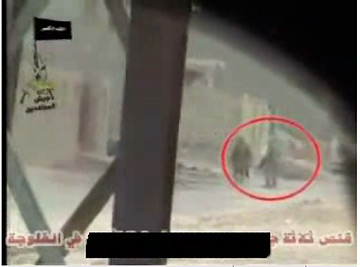INTERNET: WATCHING AMERICANS DIE
 This image from YouTube.com is of a soldier about to be shot by a sniper; the others shown below are bombings of Americans.
This image from YouTube.com is of a soldier about to be shot by a sniper; the others shown below are bombings of Americans.
|
Web videos mock U.S. war deaths
Posted on YouTube.com, the clips include insurgent slogans and have been viewed thousands of times
The wildly popular video-sharing Web site YouTube.com has dozens of videos purporting to show individual American soldiers being killed in Iraq, in what amounts to snuff films, overlaid with music and insurgent slogans.
Some of the videos, including ones of American soldiers purportedly being picked off by snipers or being blown up by improvised explosive devices, have been viewed tens of thousands of times each in the past few months. Some are posted in YouTube's "news and blogs" category, but others are listed under "entertainment" and even "comedy."
One shows what appears to be three U.S. soldiers in desert fatigues questioning Iraqi men in a street or alley as young boys mingle around. Suddenly, one soldier slumps to the ground, felled by a single bullet, as the children scatter. In another, a U.S. soldier is standing through the top hatch of a Humvee, then slumps over as the sniper strikes.
Their presence on YouTube shows that insurgent propaganda -- including genuine footage -- already available on more obscure Web sites has seeped in the mainstream of American popular culture, said Eben Kaplan, assistant editor of CFR.org, the Web site of the Council on Foreign Relations, a nonpartisan think tank headquartered in New York.
 These images from YouTube.com purportedly show attacks on U.S. troops in Iraq. These images are bombings of Americans.
These images from YouTube.com purportedly show attacks on U.S. troops in Iraq. These images are bombings of Americans.
|
"It is authentic. Most of (the videos) have insignia of Iraqi insurgent groups" and some likely were reposted from jihadist Web sites, said Kaplan, who has written extensively about terrorists' use of the Internet. "That it's being picked up in YouTube does give it a much wider audience."
Kaplan said the Internet is an important tool for insurgents in Iraq, who use it to attract recruits and funding, create a network of sympathizers, and to try to demoralize American soldiers and citizens.
YOUTUBE, based in San Mateo, Calif., has grown astronomically since it was launched in December. The free site allows users to post and view video footage from around the world. More than 100 million videos are viewed each day, and 65,000 new ones added, according to the Web site.
Calls and e-mails to YouTube requesting an interview regarding the war videos went unreturned. The Web site's "terms of use" and "safety tips" sections make it clear that the organization -- which describes itself as a "consumer media company" and "entertainment destination" -- expects users to police themselves.
The "safety tips" states that "YouTube doesn't allow videos with nudity, graphic violence or hate" and advises users who find violations to flag the videos and report them to YouTube.
Some of the graphic war images are flagged as objectionable, but come into view after the user clicks on a box acknowledging that the video contains graphic content.
The "terms of use" section says YouTube reserves the sole right to remove videos and to terminate a user's access for violating its policies.
The section goes on to say that users understand they may be exposed to videos that are "inaccurate, offensive, indecent or objectionable" and that YouTube holds no liability.
The Star-Bulletin also tried to contact MeTaLhEaD696, the user name of someone who posted several videos of Americans being shot. The person did not respond to e-mailed requests for an interview.
The anti-U.S. videos generate visceral reactions by viewers, with their posted comments revealing the breadth and depth of responses: from the unbridled glee of insurgent sympathizers, to the outrage expressed by Americans vowing revenge, to the assertion that the harsh images reveal the reality U.S. soldiers face in unpredictable urban warfare. There also are crass comments by people who enjoy so-called "war porn" and endless speculation about who filmed the footage, who posted it and what their motivations were.
The phenomenon illustrates the huge power of the Internet in 21st-century warfare, both as a propaganda tool and as a means of instant communication among far-flung but like-minded individuals. (YouTube users can post comments to the general group, and can also communicate privately with each other.)
THE SITE ALSO holds numerous equally violent videos that claim to show U.S. soldiers killing people in Iraq and Afghanistan.
Users who say none of the images should be censored call the Internet videos the flip side of mainstream American news coverage from the beginning of the Iraq war, when journalists were embedded with U.S. troops and filmed battles from the American point of view.
But besides showing dead Americans and glorifying anti-U.S. fighters, the footage on YouTube.com and other video-sharing sites tends to be much more graphic than war footage seen on regular television, and offers little or no context.
"These videos are frankly pretty sickening," said Kaplan, who noted that one added a laugh track and funny sound effects to the scenes of soldiers dying.
"The Internet is by and large uncensored, and I personally feel for the most part that's good," he said, but added that "it's very disturbing" to think of people viewing such death scenes as entertainment.
Lt. Cmdr. Jason Salata, spokesman for the U.S. Pacific Command, refused to comment specifically about videos on YouTube but gave a general statement. "The U.S. military is aware that disturbing images are out on the Internet, but their use or placement is up to the individuals or editorial staffs that choose to publish them," Salata said.

